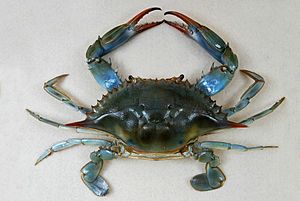Callinectes facts for kids
Quick facts for kids Callinectes |
|
|---|---|
 |
|
| Callinectes sapidus | |
| Scientific classification | |
| Kingdom: | |
| Phylum: | |
| Subphylum: | |
| Class: |
Malacostraca
|
| Order: |
Decapoda
|
| Infraorder: | |
| Family: |
Portunidae
|
| Genus: |
Callinectes
Stimpson, 1860
|
Callinectes is a group of crabs often called blue crabs. These amazing creatures are known for their strong swimming abilities and often have bluish colors. There are sixteen different types, or species, of crabs in this group. The most famous one is the Atlantic blue crab, known scientifically as C. sapidus. Blue crabs are found in many parts of the world, especially in coastal waters.
Contents
What are Blue Crabs?
Blue crabs are a type of crab that belongs to the family Portunidae. This family is known for its members having flat, paddle-like back legs. These special legs help them swim quickly through the water. Most crabs walk sideways, but blue crabs can swim forward and backward with ease.
Where Do Blue Crabs Live?
Blue crabs live in many different places around the world. They prefer shallow, warm waters. You can find them in estuaries, which are places where rivers meet the sea. They also live in bays and lagoons. These areas offer plenty of food and protection.
Habitat and Diet
Blue crabs often hide in seagrass beds or muddy bottoms. They are very good at camouflaging themselves. They are also omnivores, meaning they eat both plants and animals. Their diet includes small fish, clams, oysters, and even other crabs. They use their strong claws to catch and crush their food.
Different Types of Callinectes
The Callinectes group includes sixteen known species. Each species has its own unique features. They all share the general characteristics of blue crabs. The Atlantic blue crab (C. sapidus) is the most well-known. It is important for fishing and food in many areas.
Here are some of the species found in the Callinectes genus:
- Callinectes affinis Fausto, 1980
- Callinectes amnicola (Rochebrune, 1883)
- Callinectes arcuatus Ordway, 1863
- Callinectes bellicosus Stimpson, 1859
- Callinectes bocourti A. Milne-Edwards, 1879
- Callinectes danae Smith, 1869
- Callinectes diacanthus
- Callinectes exasperatus (Gerstaecker, 1856)
- Callinectes gladiator Benedict, 1893
- Callinectes marginatus (A. Milne-Edwards, 1861)
- Callinectes ornatus Ordway, 1863
- Callinectes pallidus (Rochebrune, 1883)
- Callinectes rathbunae Contreras, 1930
- Callinectes sapidus Rathbun, 1896
- Callinectes similis Williams, 1966
- Callinectes toxotes Ordway, 1863
Why are Blue Crabs Important?
Blue crabs play a vital role in their ecosystems. They help keep the balance of marine life. They are also a major food source for many larger animals. These include fish, birds, and even humans. Fishing for blue crabs is an important industry in many coastal regions.
Life Cycle of a Blue Crab
Blue crabs go through several stages in their lives. Females lay millions of tiny eggs. These eggs hatch into larvae, which are very small and float in the water. The larvae grow and change shape many times. They eventually become tiny crabs. These young crabs then grow into adults.
Molting Process
As blue crabs grow, they shed their hard outer shell. This process is called molting. It allows them to get bigger. During molting, the crab is soft and vulnerable. It will hide until its new shell hardens. This can take a few days.
See also
 In Spanish: Callinectes para niños
In Spanish: Callinectes para niños

